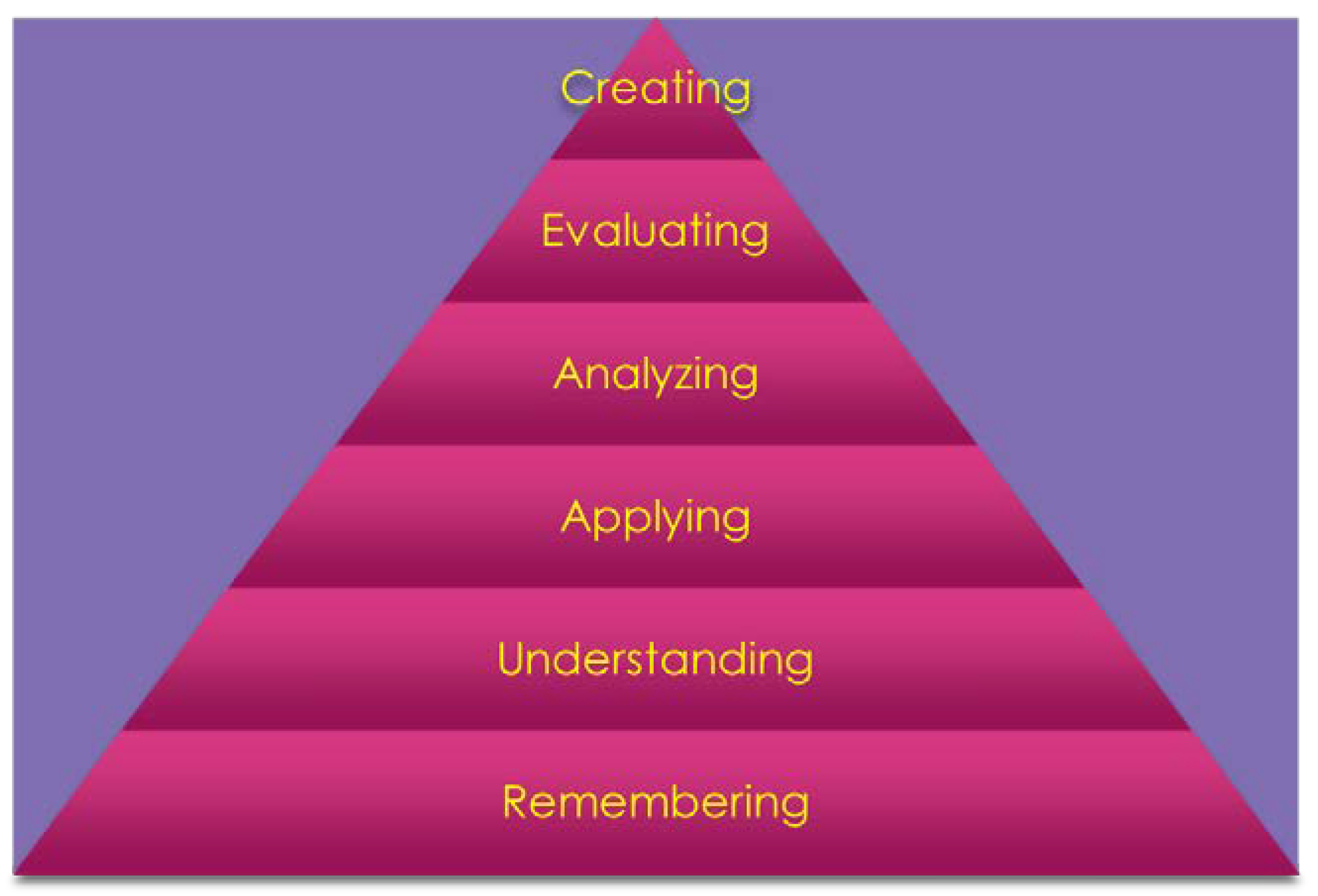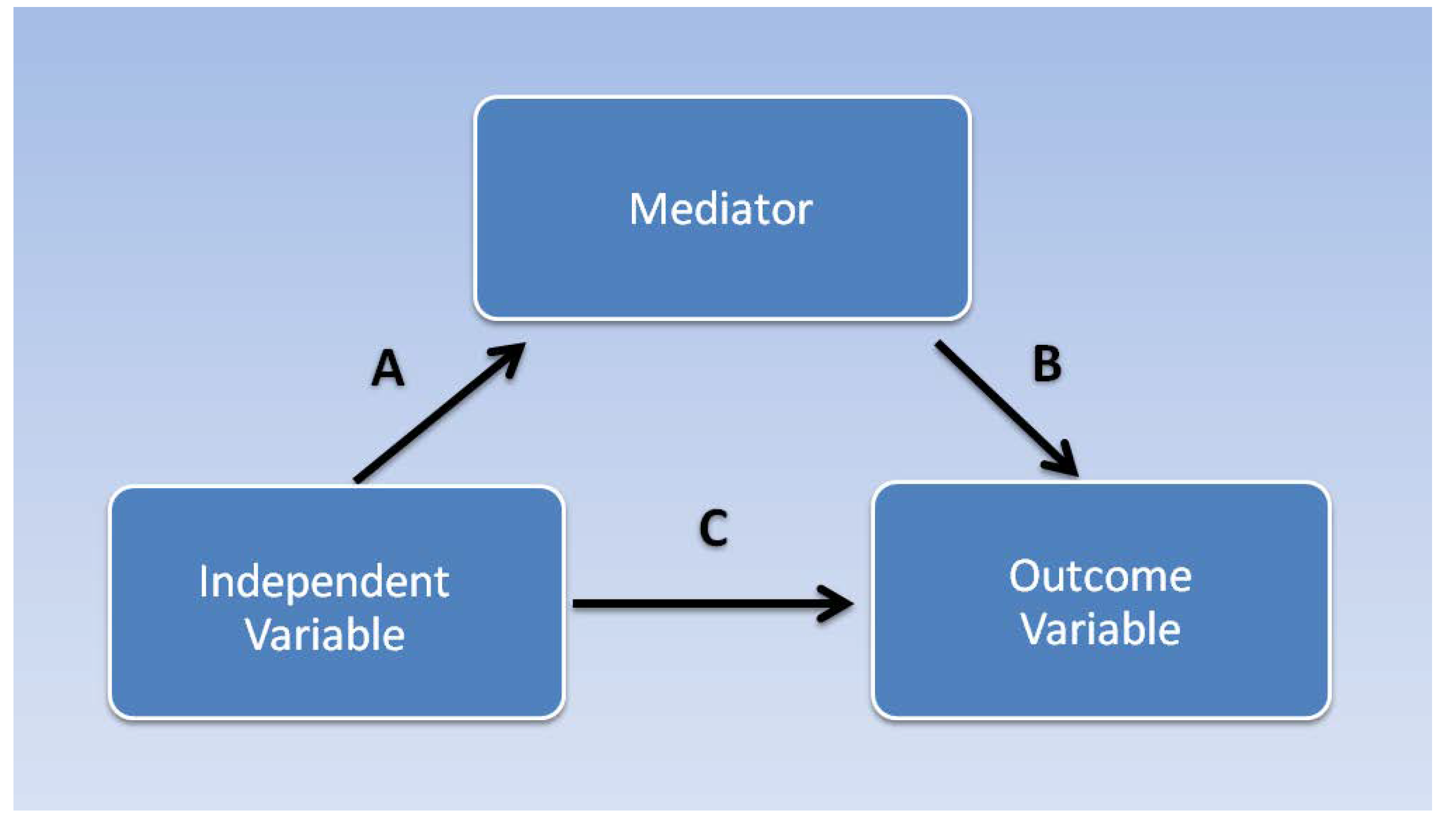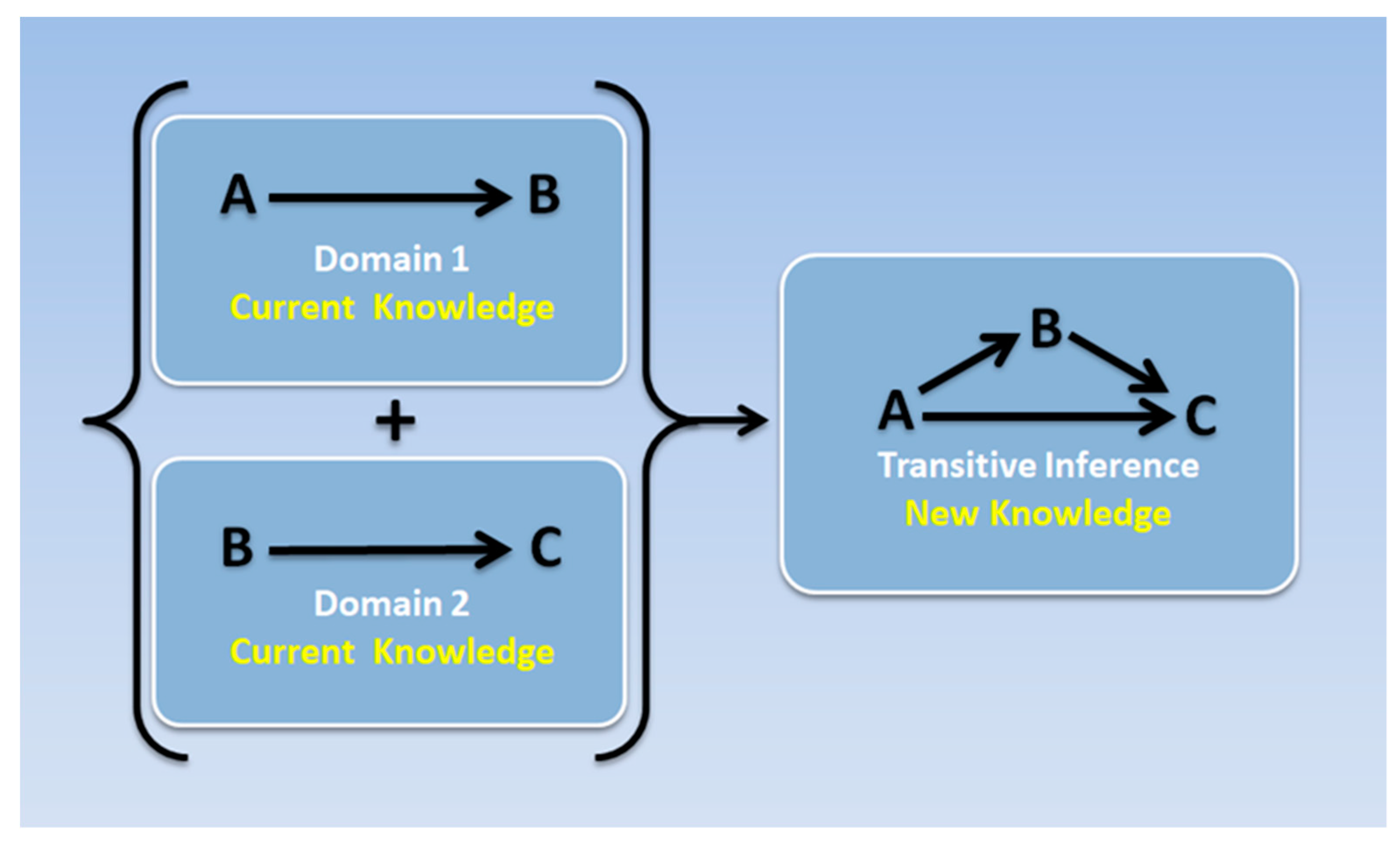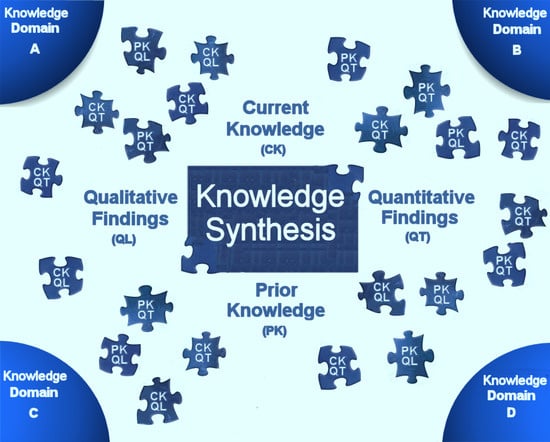Breakthrough Knowledge Synthesis in the Age of Google
Abstract
1. Introduction
2. Synthesis
3. Synthesis in Education
4. Synthesizing an Explanatory Theory
5. Domain-Specific Knowledge
6. Association, Causation, and Mediation
6.1. Association
6.2. Causation
- Strength of the association: stronger associations are more likely causal.
- Consistency: causal findings are similar across multiple studies.
- Specificity of the association: a cause produces a specific result.
- Temporality: the cause precedes the result.
- Biological gradient: the quantity of the cause determines the result size.
- Plausibility: the cause may be explained by current knowledge.
- Coherence: the cause is a good fit with related knowledge.
- Experimental evidence: the cause occurs under controlled conditions.
- Analogy: the cause is observed under similar circumstances.
6.3. Mediation
 ) to represent variables linked indirectly with an unspecified common cause. When conducting a synthesis, the researcher may infer the mediating common cause that indirectly links two variables. To illustrate, low vitamin D levels in patients have been associated with a higher risk of cancer incidence [77]. Based on this association, some researchers have proposed that taking vitamin D supplements may prevent cancer, but recently published clinical trials of vitamin D supplements and cancer prevention do not support this causal inference [78,79,80]. Having coauthored a textbook chapter on the endocrine regulation of phosphate homeostasis [81], I have background knowledge of vitamin D’s role in regulating intestinal absorption of dietary phosphorus—i.e., vitamin D levels are lowered if phosphorus serum levels rise too high, as in clinical and subclinical hyperphosphatemia. Synthesizing the link between lowered vitamin D and hyperphosphatemia with the link between hyperphosphatemia and tumorigenesis [61], I proposed that hyperphosphatemia is a common cause that mediates an indirect association between lowered vitamin D levels and increased cancer risk [69].
) to represent variables linked indirectly with an unspecified common cause. When conducting a synthesis, the researcher may infer the mediating common cause that indirectly links two variables. To illustrate, low vitamin D levels in patients have been associated with a higher risk of cancer incidence [77]. Based on this association, some researchers have proposed that taking vitamin D supplements may prevent cancer, but recently published clinical trials of vitamin D supplements and cancer prevention do not support this causal inference [78,79,80]. Having coauthored a textbook chapter on the endocrine regulation of phosphate homeostasis [81], I have background knowledge of vitamin D’s role in regulating intestinal absorption of dietary phosphorus—i.e., vitamin D levels are lowered if phosphorus serum levels rise too high, as in clinical and subclinical hyperphosphatemia. Synthesizing the link between lowered vitamin D and hyperphosphatemia with the link between hyperphosphatemia and tumorigenesis [61], I proposed that hyperphosphatemia is a common cause that mediates an indirect association between lowered vitamin D levels and increased cancer risk [69].7. Conclusions
Funding
Conflicts of Interest
References
- Grimm, S.R.; Baumberger, C.; Ammon, S. Explaining Understanding: New Perspectives from Epistemology and Philosophy of Science; Taylor & Francis: Abingdon, UK, 2016. [Google Scholar]
- Burnyeat, M. The Theaetetus of Plato; Hackett Publishing: Indianapolis, IN, USA, 1990. [Google Scholar]
- Gettier, E.L. Is justified true belief knowledge? Analysis 1963, 23, 121–123. [Google Scholar] [CrossRef]
- Turnbull, H.W. The Correspondence of Isaac Newton: 1661–1675; Cambridge University Press: Cambridge, UK, 1959. [Google Scholar]
- Mukherjee, S.; Romero, D.M.; Jones, B.; Uzzi, B. The nearly universal link between the age of past knowledge and tomorrow’s breakthroughs in science and technology: The hotspot. Sci. Adv. 2017, 3, e1601315. [Google Scholar] [CrossRef] [PubMed]
- Markos, L. God and Galileo: What a 400-Year-Old Letter Teaches Us about Faith and Science. Christ. Sch. Rev. 2019, 49, 99–102. [Google Scholar]
- Kuhn, T.S. The Structure of Scientific Revolutions; University of Chicago Press: Chicago, IL, USA, 1962. [Google Scholar]
- Dewar, J.A. The Information Age and the Printing Press: Looking Backward to See Ahead; RAND Corporation: Santa Monica, CA, USA, 1998. [Google Scholar]
- Shrivastav, H.; Hiltz, S.R. Information overload in technology-based education: A meta-analysis. In Proceedings of the 19th Americas Conference on Information Systems, Chicago, IL, USA, 15–17 August 2013. [Google Scholar]
- Williams, R. Keywords (Routledge Revivals): A Vocabulary of Culture and Society; Routledge: London, UK, 2013. [Google Scholar]
- Garson, D.; Lillvik, C.; Sisk, E.; Ewing, E.; Johnson, M. The Literature Review: A Research Journey. Harvard Graduate School of Education. 2016. Available online: https://guides.library.harvard.edu/literaturereview (accessed on 27 April 2019).
- Kastner, M.; Tricco, A.C.; Soobiah, C.; Lillie, E.; Perrier, L.; Horsley, T.; Welch, V.; Cogo, E.; Antony, J.; Straus, S.E. What is the most appropriate knowledge synthesis method to conduct a review? Protocol for a scoping review. BMC Med. Res. Methodol. 2012, 12, 114. [Google Scholar] [CrossRef]
- Sutton, A.J.; Abrams, K.R. Bayesian methods in meta-analysis and evidence synthesis. Stat. Methods Med. Res. 2001, 10, 277–303. [Google Scholar] [CrossRef]
- Stemler, S. An overview of content analysis. Pract. Assess. Res. Eval. 2001, 7, 137–146. [Google Scholar]
- Dixon-Woods, M.; Cavers, D.; Agarwal, S.; Annandale, E.; Arthur, A.; Harvey, J.; Hsu, R.; Katbamna, S.; Olsen, R.; Smith, L. Conducting a critical interpretive synthesis of the literature on access to healthcare by vulnerable groups. BMC Med. Res. Methodol. 2006, 6, 35. [Google Scholar] [CrossRef]
- Droitcour, J.; Silberman, G.; Chelimsky, E. Cross-design synthesis: A new form of meta-analysis for combining results from randomized clinical trials and medical-practice databases. Int. J. Technol. Assess. Health Care 1993, 9, 440–449. [Google Scholar] [CrossRef]
- Banning, J.H. Ecological triangulation: An approach for qualitative meta-synthesis. Available online: http://citeseerx.ist.psu.edu/viewdoc/download?doi=10.1.1.152.5185&rep=rep1&type=pdf (accessed on 4 February 2020).
- Pope, C.; Ziebland, S.; Mays, N. Qualitative research in health care: Analysing qualitative data. BMJ Br. Med J. 2000, 320, 114. [Google Scholar] [CrossRef]
- Strauss, A.; Corbin, J. Basics of Qualitative Research Techniques: Techniques and Procedures for Developing Grounded Theory; Sage publications: Thousand Oaks, CA, USA, 1998. [Google Scholar]
- Noblit, G.W.; Hare, R.D. Meta-Ethnography: Synthesizing Qualitative Studies; Sage: Thousand Oaks, CA, USA, 1988; Volume 11. [Google Scholar]
- Weed, M. “Meta Interpretation”: A Method for the Interpretive Synthesis of Qualitative Research. Forum Qual. Soc. Res. 2005, 6, 1–21. [Google Scholar]
- Greenhalgh, T.; Robert, G.; Macfarlane, F.; Bate, P.; Kyriakidou, O.; Peacock, R. Storylines of research in diffusion of innovation: A meta-narrative approach to systematic review. Soc. Sci. Med. 2005, 61, 417–430. [Google Scholar] [CrossRef] [PubMed]
- Paterson, B.L.; Thorne, S.E.; Canam, C.; Jillings, C. Meta-Study of Qualitative Health Research: A Practical Guide to Meta-Analysis and Meta-Synthesis; Sage: Thousand Oaks, CA, USA, 2001; Volume 3. [Google Scholar]
- Sandelowski, M.; Barroso, J. Creating metasummaries of qualitative findings. Nurs. Res. 2003, 52, 226–233. [Google Scholar] [CrossRef] [PubMed]
- Sandelowski, M.; Docherty, S.; Emden, C. Qualitative metasynthesis: Issues and techniques. Res. Nurs. Health 1997, 20, 365–371. [Google Scholar] [CrossRef]
- Pluye, P.; Gagnon, M.-P.; Griffiths, F.; Johnson-Lafleur, J. A scoring system for appraising mixed methods research, and concomitantly appraising qualitative, quantitative and mixed methods primary studies in mixed studies reviews. Int. J. Nurs. Stud. 2009, 46, 529–546. [Google Scholar] [CrossRef] [PubMed]
- Dixon-Woods, M.; Agarwal, S.; Jones, D.; Young, B.; Sutton, A. Synthesising qualitative and quantitative evidence: A review of possible methods. J. Health Serv. Res. Policy 2005, 10, 45–53. [Google Scholar] [CrossRef]
- Popay, J.; Roberts, H.; Sowden, A.; Petticrew, M.; Arai, L.; Rodgers, M.; Britten, N.; Roen, K.; Duffy, S. Guidance on the conduct of narrative synthesis in systematic reviews. In Results of An ESRC Funded Research Project; Unpublished Report; University of Lancaster: Lancaster, UK, 2006. [Google Scholar]
- Yin, R. Case Study Research–Design and Methods; Applied Social Research Methods Series; Sage Publications: Thousand Oaks, CA, USA, 2003; Volume 5. [Google Scholar]
- Jensen, L.A.; Allen, M.N. Meta-synthesis of qualitative findings. Qual. Health Res. 1996, 6, 553–560. [Google Scholar] [CrossRef]
- Grant, M.J.; Booth, A. A typology of reviews: An analysis of 14 review types and associated methodologies. Health Inf. Libr. J. 2009, 26, 91–108. [Google Scholar] [CrossRef]
- Yin, R.K.; Heald, K.A. Using the case survey method to analyze policy studies. Adm. Sci. Q. 1975, 20, 371–381. [Google Scholar] [CrossRef]
- Pawson, R.; Greenhalgh, T.; Harvey, G.; Walshe, K. Realist review-a new method of systematic review designed for complex policy interventions. J. Health Serv. Res. Policy 2005, 10, 21–34. [Google Scholar] [CrossRef]
- Lucas, P.J.; Baird, J.; Arai, L.; Law, C.; Roberts, H.M. Worked examples of alternative methods for the synthesis of qualitative and quantitative research in systematic reviews. BMC Med. Res. Methodol. 2007, 7, 4. [Google Scholar] [CrossRef]
- Mays, N.; Pope, C.; Popay, J. Systematically reviewing qualitative and quantitative evidence to inform management and policy-making in the health field. J. Health Serv. Res. Policy 2005, 10, 6–20. [Google Scholar] [CrossRef] [PubMed]
- Thomas, J.; Harden, A. Methods for the thematic synthesis of qualitative research in systematic reviews. BMC Med. Res. Methodol. 2008, 8, 45. [Google Scholar] [CrossRef] [PubMed]
- Wyborn, C.; Louder, E.; Harrison, J.; Montambault, J.; Montana, J.; Ryan, M.; Bednarek, A.; Nesshöver, C.; Pullin, A.; Reed, M. Understanding the Impacts of Research Synthesis. Environ. Sci. Policy 2018, 86, 72–84. [Google Scholar] [CrossRef]
- Schick-Makaroff, K.; MacDonald, M.; Plummer, M.; Burgess, J.; Neander, W. What synthesis methodology should I use? A review and analysis of approaches to research synthesis. AIMS Public Health 2016, 3, 172. [Google Scholar] [CrossRef] [PubMed]
- Downs, F.S.; Fawcett, J. The Relationship of Theory and Research; McGraw-Hill/Appleton & Lange: London, UK, 1986. [Google Scholar]
- Hjørland, B. Domain analysis. Ko Knowl. Organ. 2017, 44, 436–464. [Google Scholar] [CrossRef]
- Martínez, V.; Berzal, F.; Cubero, J.-C. A survey of link prediction in complex networks. ACM Comput. Surv. (CSUR) 2016, 49, 1–33. [Google Scholar] [CrossRef]
- Liben-Nowell, D.; Kleinberg, J. The link-prediction problem for social networks. J. Am. Soc. Inf. Sci. Technol. 2007, 58, 1019–1031. [Google Scholar] [CrossRef]
- Qi, Y.; Bar-Joseph, Z.; Klein-Seetharaman, J. Evaluation of different biological data and computational classification methods for use in protein interaction prediction. Proteins Struct. Funct. Bioinform. 2006, 63, 490–500. [Google Scholar] [CrossRef] [PubMed]
- Cumming, A.; Lai, C.; Cho, H. Students’ writing from sources for academic purposes: A synthesis of recent research. J. Engl. Acad. Purp. 2016, 23, 47–58. [Google Scholar] [CrossRef]
- Bloom, B.; Krathwohl, D. Taxonomy of Educational Objectives: The Classification of Educational Goals by A Committee of College and University Examiners; Domain, H.I.C., Ed.; Longman: New York, NY, USA, 1956. [Google Scholar]
- Forehand, M. Bloom’s taxonomy. Emerg. Perspect. Learn. Teach. Technol. 2010, 41, 47–56. [Google Scholar]
- Carpenter, S.R.; Armbrust, E.V.; Arzberger, P.W.; Chapin, F.S., III; Elser, J.J.; Hackett, E.J.; Ives, A.R.; Kareiva, P.M.; Leibold, M.A.; Lundberg, P. Accelerate synthesis in ecology and environmental sciences. Bioscience 2009, 59, 699–701. [Google Scholar] [CrossRef]
- Zee, M.; De Boer, M.; Jaarsma, A. Acquiring evidence-based medicine and research skills in the undergraduate medical curriculum: Three different didactical formats compared. Perspect. Med Educ. 2014, 3, 357–370. [Google Scholar] [CrossRef][Green Version]
- National Commission on Writing in America’s Schools and Colleges. Writing: A ticket to work…or a ticket out: A survey of business leaders. 2004. Available online: http://www.writingcommission.org/prod_downloads/writingcom/writing-ticket-to-work.pdf (accessed on 7 November 2019).
- National Commission on Writing. Writing: A Powerful Message from State Government. Available online: http://www.writingcommission.org/prod_downloads/writingcom/powerful-message-from-state (accessed on 7 November 2019).
- Magrath, C.; Ackerman, A.; Branch, T.; Clinton Bristow, J.; Shade, L.; Elliott, J.; Williams, R. The Neglected “R”: The Need for A Writing Revolution; College Entrance Examination Board; The National Commission on Writing: New York, NY, USA, 2003. [Google Scholar]
- Luo, L.; Kiewra, K.A. A SOAR-Fired Method for Teaching Synthesis Writing; IDEA Paper# 74; IDEA Center, Inc.: Fort Recovery, OH, USA, 2019. [Google Scholar]
- Lai, C.C.; Lik, H.C.; Pheng, O.S.; Shee, L.S.; Joyce, T.T.; Rosli, N. Enhancing classroom engagement through web-based interactive tools. Proc. Mech. Eng. Res. Day 2019 2019, 2019, 218–220. [Google Scholar]
- Leu, D.J.; Kinzer, C.K.; Coiro, J.; Castek, J.; Henry, L.A. New literacies: A dual-level theory of the changing nature of literacy, instruction, and assessment. J. Educ. 2017, 197, 1–18. [Google Scholar] [CrossRef]
- Marrow, A.J. The Practical Theorist: The Life and Work of Kurt Lewin; Teachers College Press: New York, NY, USA, 1977. [Google Scholar]
- Glaser, B.G.; Strauss, A.L. Discovery of Grounded Theory: Strategies for Qualitative Research; Routledge: New York, NY, USA, 2017. [Google Scholar] [CrossRef]
- Chun Tie, Y.; Birks, M.; Francis, K. Grounded theory research: A design framework for novice researchers. SAGE Open Med. 2019, 7. [Google Scholar] [CrossRef] [PubMed]
- Ioannidis, J.P. The mass production of redundant, misleading, and conflicted systematic reviews and meta-analyses. Milbank Q. 2016, 94, 485–514. [Google Scholar] [CrossRef]
- Schafer, A.I.; Mann, D.L. Current Education of Physicians: Lost in Translation? JACC Basic Transl. Sci. 2019, 4, 655–657. [Google Scholar] [CrossRef]
- Wolfswinkel, J.F.; Furtmueller, E.; Wilderom, C.P. Using grounded theory as a method for rigorously reviewing literature. Eur. J. Inf. Syst. 2013, 22, 45–55. [Google Scholar] [CrossRef]
- Brown, R.B.; Razzaque, M.S. Phosphate toxicity and tumorigenesis. Biochim. Biophys. Acta Rev. Cancer 2018. [Google Scholar] [CrossRef]
- Bu, Y.; Waltman, L.; Huang, Y. A multidimensional perspective on the citation impact of scientific publications. arXiv 2019, arXiv:1901.09663. [Google Scholar]
- Hanahan, D.; Weinberg, R.A. The hallmarks of cancer. Cell 2000, 100, 57–70. [Google Scholar] [CrossRef]
- Ackerman, P.L. Domain-specific knowledge as the “dark matter” of adult intelligence: Gf/Gc, personality and interest correlates. J. Gerontol. Ser. B Psychol. Sci. Soc. Sci. 2000, 55, 69–84. [Google Scholar] [CrossRef] [PubMed]
- Green, B.N.; Johnson, C.D.; Adams, A. Writing narrative literature reviews for peer-reviewed journals: Secrets of the trade. J. Chiropr. Med. 2006, 5, 101–117. [Google Scholar] [CrossRef]
- Karpicke, J. A powerful way to improve learning and memory: Practicing retrieval enhances long-term, meaningful learning. Psychol. Sci. Agenda. Available online: http://www.apa.org/science/about/psa/2016/06/learning-memory.aspx: (accessed on 9 December 2019).
- Logan, R.K. In Praise of and a Critique of Nicholas Maxwell’s In Praise of Natural Philosophy: A Revolution for Thought and Life. Philosophies 2018, 3, 20. [Google Scholar] [CrossRef]
- Katila, R.; Ahuja, G. Something old, something new: A longitudinal study of search behavior and new product introduction. Acad. Manage. J. 2002, 45, 1183–1194. [Google Scholar]
- Brown, R.B. Vitamin D, cancer, and dysregulated phosphate metabolism. Endocrine 2019, 1–6. [Google Scholar] [CrossRef]
- Harwood, W.S.; Reiff, R.R.; Phillipson, T. Putting the Puzzle Together: Scientists’ Metaphors for Scientific Inquiry. Sci. Educ. 2005, 14, 25–30. [Google Scholar]
- Lepley, W.M. “The Maturity of the Chances”: A Gambler’s Fallacy. J. Psychol. 1963, 56, 69–72. [Google Scholar] [CrossRef]
- Fedak, K.M.; Bernal, A.; Capshaw, Z.A.; Gross, S. Applying the Bradford Hill criteria in the 21st century: How data integration has changed causal inference in molecular epidemiology. Emerg. Themes Epidemiol. 2015, 12, 14. [Google Scholar] [CrossRef]
- Rohrer, J.M. Thinking clearly about correlations and causation: Graphical causal models for observational data. Adv. Methods Pract. Psychol. Sci. 2018, 1, 27–42. [Google Scholar] [CrossRef]
- Baron, R.M.; Kenny, D.A. The moderator–mediator variable distinction in social psychological research: Conceptual, strategic, and statistical considerations. J. Pers. Soc. Psychol. 1986, 51, 1173. [Google Scholar] [CrossRef] [PubMed]
- Robins, J.M. Data, design, and background knowledge in etiologic inference. Epidemiology 2001, 12, 313–320. [Google Scholar] [CrossRef] [PubMed]
- Greenland, S.; Pearl JBoslaugh, S. Causal diagrams. In Encyclopedia of Epidemiology; Boslaugh, S.E., Ed.; Calif SAGE Publications: Thousand Oaks, CA, USA, 2008. [Google Scholar]
- Bikle, D.D. Vitamin D and cancer: The promise not yet fulfilled. Endocrine 2014, 46, 29–38. [Google Scholar] [CrossRef] [PubMed]
- Manson, J.E.; Cook, N.R.; Lee, I.-M.; Christen, W.; Bassuk, S.S.; Mora, S.; Gibson, H.; Gordon, D.; Copeland, T.; D’Agostino, D. Vitamin D supplements and prevention of cancer and cardiovascular disease. N. Engl. J. Med. 2019, 380, 33–44. [Google Scholar] [CrossRef]
- Scragg, R.; Khaw, K.-T.; Toop, L.; Sluyter, J.; Lawes, C.M.; Waayer, D.; Giovannucci, E.; Camargo, C.A. Monthly high-dose vitamin D supplementation and cancer risk: A post hoc analysis of the vitamin D assessment randomized clinical trial. JAMA Oncol. 2018, 4, e182178. [Google Scholar] [CrossRef]
- Keum, N.; Lee, D.; Greenwood, D.; Manson, J.; Giovannucci, E. Vitamin D supplementation and total cancer incidence and mortality: A meta-analysis of randomized controlled trials. Ann. Oncol. 2019. [Google Scholar] [CrossRef]
- Brown, R.B.; Razzaque, M.S. Chapter 31—Endocrine Regulation of Phosphate Homeostasis. In Textbook of Nephro-Endocrinology, 2nd ed.; Singh, A.K., Williams, G.H., Eds.; Academic Press: Cambridge, MA, USA, 2018; pp. 539–548. [Google Scholar] [CrossRef]
- Swanson, D.R. Undiscovered public knowledge. Libr. Q. 1986, 56, 103–118. [Google Scholar] [CrossRef]
- Brown, R.B. Phospholipid packing defects and oxysterols in atherosclerosis: Dietary prevention and the French paradox. Biochimie 2019. [Google Scholar] [CrossRef]




| Knowledge Synthesis Method | Author |
|---|---|
| Bayesian meta-analysis | Sutton [13] |
| Content analysis | Stemler [14] |
| Critical interpretive synthesis | Dixon-Woods, [15] |
| Cross-design synthesis | Droitcour [16] |
| Ecological triangulation | Banning [17] |
| Framework synthesis | Pope [18] |
| Grounded theory | Strauss [19] |
| Interpretive synthesis/Integrative synthesis | Noblit, [20] |
| Meta-ethnography | Noblit [20] |
| Meta-interpretation | Weed [21] |
| Meta-narrative | Greenhalgh [22] |
| Meta-study | Paterson [23] |
| Meta-summary | Sandelowski [24] |
| Meta-synthesis | Sandelowski [25] |
| Mixed studies review | Pluye [26] |
| Narrative review/summary | Dixon-Woods [27] |
| Narrative synthesis | Popay [28] |
| Qualitative cross-case analysis | Yin [29] |
| Qualitative meta-synthesis | Jensen [30] |
| Qualitative systematic review/evidence synthesis | Grant [31] |
| Quantitative case survey | Yin [32] |
| Realist review/synthesis | Pawson [33] |
| Textual Narrative synthesis | Lucas [34] |
| Thematic analysis | Mays [35] |
| Thematic synthesis | Thomas [36] |
© 2020 by the author. Licensee MDPI, Basel, Switzerland. This article is an open access article distributed under the terms and conditions of the Creative Commons Attribution (CC BY) license (http://creativecommons.org/licenses/by/4.0/).
Share and Cite
Brown, R.B. Breakthrough Knowledge Synthesis in the Age of Google. Philosophies 2020, 5, 4. https://doi.org/10.3390/philosophies5010004
Brown RB. Breakthrough Knowledge Synthesis in the Age of Google. Philosophies. 2020; 5(1):4. https://doi.org/10.3390/philosophies5010004
Chicago/Turabian StyleBrown, Ronald B. 2020. "Breakthrough Knowledge Synthesis in the Age of Google" Philosophies 5, no. 1: 4. https://doi.org/10.3390/philosophies5010004
APA StyleBrown, R. B. (2020). Breakthrough Knowledge Synthesis in the Age of Google. Philosophies, 5(1), 4. https://doi.org/10.3390/philosophies5010004






